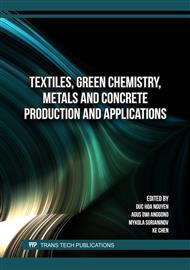p.49
p.55
p.63
p.71
p.79
p.87
p.95
p.103
p.113
Research of Warp Structure Modelling for Calculation of Two Guidebars Warp Knitted Fabric Parameters
Abstract:
Abstract. Warp knitted fabrics were known as rather complicated structures. Until now, only geometrical models for general warp knitted structures were presented. Calculation of two guidebars warp knitted fabric parameters using geometrical models was limited. This paper presented an extension of available geometrical models for simulation warp knitted structures parameters such as fabric thickness, looplength, warp and weft density, fabric area porosity, fabric mass density. The theorical parameters were compared to experimental parameters to verify the built fabric model during the calculation of the geometrical form warp knitted structures. The proposed geometrical model was applied for two types of tricot-tricot fabric knitted from polyamide and polyurethane with different yarn counts. The results showed the differences between theorical parameters calculated by the model and the experimental parameters were 1% - 4% for fabric area mass, up to 9% for the fabric warp and weft density and about 90 % difference in fabric area porosity, which recommended the built model could be applied to calculate the fabric parameters and need to continue developing for of the physico-mechanical warp knitted properties.
Info:
Periodical:
Pages:
79-86
Citation:
Online since:
December 2024
Authors:
Price:
Сopyright:
© 2024 Trans Tech Publications Ltd. All Rights Reserved
Share:
Citation:



